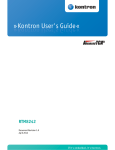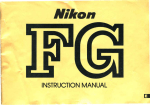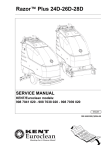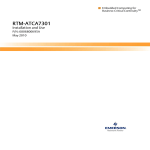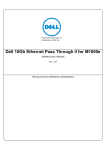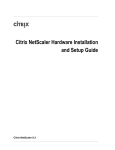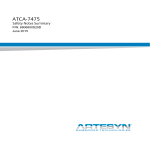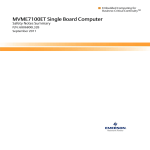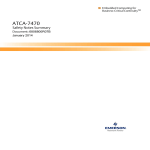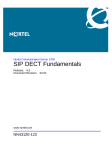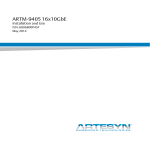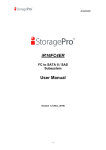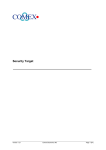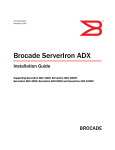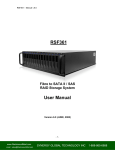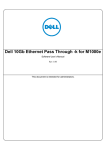Download RTM-ATCA-9305 I/O - Artesyn Embedded Technologies
Transcript
RTM-ATCA-9305 I/O Installation and Use The information in this manual has been checked and is believed to be accurate and reliable. HOWEVER, NO RESPONSIBILITY IS ASSUMED BY EMERSON NETWORK POWER, EMBEDDED COMPUTING FOR ITS USE OR FOR ANY INACCURACIES. Specifications are subject to change without notice. EMERSON DOES NOT ASSUME ANY LIABILITY ARISING OUT OF USE OR OTHER APPLICATION OF ANY PRODUCT, CIRCUIT, OR PROGRAM DESCRIBED HEREIN. This document does not convey any license under Emerson patents or the rights of others. Emerson. Consider It Solved is a trademark, and Business-Critical Continuity, Emerson Network Power, and the Emerson Network Power logo are trademarks and service marks of Emerson Electric Co. All other brand or product names may be trademarks or registered trademarks of their respective holders. Copying and distribution of this information is prohibited. © Copyright Emerson Network Power, Embedded Computing, Inc. All rights reserved. Contents Declaration of Conformity...........................................................5 About this Manual.......................................................................6 Abbreviations...............................................................................................6 Conventions.................................................................................................7 Summary of Changes....................................................................................8 Comments and Suggestions.........................................................................8 Safety Notes................................................................................9 Sicherheitshinweise..................................................................12 Introduction..............................................................................15 Features......................................................................................................15 Standard Compliances................................................................................15 Mechanical Data.........................................................................................16 Ordering Information..................................................................................16 Board Identification....................................................................................17 Hardware Preparation and Installation......................................20 Unpacking and Inspecting the Board..........................................................20 Environmental Requirements......................................................................20 Power Requirements...................................................................................22 Installing and Removing the RTM................................................................22 Installing the RTM............................................................................23 Removing the RTM..........................................................................26 Installing and Removing SFP/SFP+ Modules................................................27 Installing an SFP/SFP+ Module.........................................................27 Removing an SFP/SFP+ Module........................................................28 LEDs and I/O Interfaces..............................................................29 Main Board Layout......................................................................................29 Sub-board Layout.......................................................................................30 On-board Connectors.................................................................................31 10010926-03 | RTM-ATCA-9305 I/O | iii Face Plate....................................................................................................32 Port Pin Assignments..................................................................................35 SFP/SFP+..........................................................................................35 COM Ports.......................................................................................37 Status LEDs.................................................................................................37 Functional Description..............................................................39 Block Diagram............................................................................................39 Ethernet Switch..........................................................................................40 10-Gigabit Ethernet Transceiver..................................................................41 Module Management Controller.................................................................41 Serial Debug Port........................................................................................42 SIPL Protocol...............................................................................................42 Emerson OEM Commands..........................................................................42 I2C Read SFP Register.......................................................................43 I2C Write SFP Register......................................................................43 Drive EEPROM..................................................................................44 Un Drive EEPROM............................................................................44 Related Documentation............................................................45 Emerson Documents..................................................................................45 Related Specifications.................................................................................45 iv | RTM-ATCA-9305 I/O | 10010926-03 Declaration of Conformity 10010926-03 | RTM-ATCA-9305 I/O | 5 About this Manual This manual has the following sections: Introduction on page 15 gives an overview of the features of the product, including mechanical, label, and ordering information. Safety Notes on page 9 lists the safety notes that should be observed when handing or operating the product. Sicherheitshinweise on page 12 lists the German translation of the safety notes. Hardware Preparation and Installation on page 20 provides information on the environmental and power requirements, as well as procedures for the installation and removal of the product. LEDs and I/O Interfaces on page 29 describes the LEDs, I/O interfaces and pin assignments, as well as the board layout. Functional Description on page 39 describes the main components found on the board. Related Documentation on page 45 provides a list of related Emerson documentation, including specifications related to the product. Abbreviations This document uses the following terms and abbreviations: Abbreviation Definition ATCA Advanced Telecommunications Computing Architecture CSA Canadian Standards Association EMC Electromagnetic Compatibility ETSI European Telecommunications Standards Institute FCC Feder Communications Commission GbE Gigabit Ethernet IEC International Electrotechnical Commission IPMB Intelligent Platform Management Bus IPMC Intelligent Platform Management Controller IPMI Intelligent Platform Management Interface NEBS Network Equipment-Building System PCIe PCI Express PICMG PCI Industrial Computer Manufacturers Group 6 | RTM-ATCA-9305 I/O | 10010926-03 About this Manual Abbreviation Definition RoHS Restriction of Hazardous Substances RTM Rear Transition Module SFP/SFP+ Small Form Factor Optical Transceiver Module SGMII Serial Gigabit Media Independent Interface UL Underwriters Laboratories Inc. WEEE Waste Electrical and Electronic Equipment XAUI 10 GbE Attachment Unit Interface Conventions The following table describes the conventions used throughout this manual. Notation Description 0x00000000 Typical notation for hexadecimal numbers (digits are 0 through F), for example used for addresses and offsets 0b0000 Same for binary numbers (digits are 0 and 1) bold Used to emphasize a word Screen Used for on-screen output and code-related elements or commands in body text Courier + Bold Used to characterize user input and to separate it from system output Reference Used for references and for table and figure descriptions File > Exit Notation for selecting a submenu [text] Notation for software buttons to click on the screen and parameter description ... Repeated item for example node 1, node 2, ..., node 12 . Omission of information from example/command that is not necessary at the time being . . 10010926-03 | RTM-ATCA-9305 I/O | 7 About this Manual Notation Description .. Ranges, for example: 0..4 means one of the integers 0,1,2,3, and 4 (used in registers) | Logical OR Indicates a hazardous situation which, if not avoided, could result in death or serious injury Indicates a hazardous situation which, if not avoided, may result in minor or moderate injury Indicates a potentially hazardous situation which, if not avoided, may result in property damage Summary of Changes This is the first edition of the RTM-ATCA-9305 Installation and Use. Part Number Publication Date Description 10010926-00 October 2008 Design availability version 10010926-01 May 2009 Updated face plate graphic, updated functional description chapter, added board identification section; Added Declaration of Conformity 10010926-02 June 2009 Added temperature critical spot 10010926-03 June 2010 Updated IPMI specifications in Features and Module Management Controller sections. Updated IPMI Sensors table. Updated Emerson OEM Commands section. Comments and Suggestions We welcome and appreciate your comments on our documentation. We want to know what you think about our manuals and how we can make them better. Mail comments to us by filling out the following online form: http://www.emersonnetworkpowerembeddedcomputing.com ➤ Contact Us ➤ Online Form In “Area of Interest” select “Technical Documentation". Be sure to include the title, part number, and revision of the manual and tell us how you used it. 8 | RTM-ATCA-9305 I/O | 10010926-03 Safety Notes This section provides warnings that precede potentially dangerous procedures throughout this manual. Instructions contained in the warnings must be followed during all phases of operation, service, and repair of this equipment. You should also employ all other safety precautions necessary for the operation of the equipment in your operating environment. Failure to comply with these precautions or with specific warnings elsewhere in this manual could result in personal injury or damage to the equipment. Emerson intends to provide all necessary information to install and handle the product in this manual. Because of the complexity of this product and its various uses, we do not guarantee that the given information is complete. If you need additional information, ask your Emerson representative. The product has been designed to meet the standard industrial safety requirements. It must not be used except in its specific area of office telecommunication industry and industrial control. Only personnel trained by Emerson or persons qualified in electronics or electrical engineering are authorized to install, remove or maintain the product. The information given in this manual is meant to complete the knowledge of a specialist and must not be used as replacement for qualified personnel. Keep away from live circuits inside the equipment. Operating personnel must not remove equipment covers. Only Factory Authorized Service Personnel or other qualified service personnel may remove equipment covers for internal subassembly or component replacement or any internal adjustment. Do not install substitute parts or perform any unauthorized modification of the equipment or the warranty may be voided. Contact your local Emerson representative for service and repair to make sure that all safety features are maintained. EMC This equipment has been tested and found to comply with the limits for a Class A digital device, pursuant to Part 15 of the FCC Rules, EN55022. These limits are designed to provide reasonable protection against harmful interference when the equipment is operated in a commercial environment. This equipment generates, uses, and can radiate radio frequency energy and, if not installed and used in accordance with the instruction manual, may cause harmful interference to radio communications. Operation of this equipment in a residential area is likely to cause harmful interference in which case the user will be required to correct the interference at his own expense. Changes or modifications not expressly approved by Emerson Network Power could void the user's authority to operate the equipment. Board products are tested in a representative system to show compliance with the above mentioned requirements. A proper installation in a compliant system will maintain the required performance. Use only shielded cables when connecting peripherals to assure that appropriate radio frequency emissions compliance is maintained. Operation Product Damage 10010926-03 | RTM-ATCA-9305 I/O | 9 Safety Notes High humidity and condensation on surfaces cause short circuits. Do not operate the product outside the specified environmental limits. Make sure the product is completely dry and there is no moisture on any surface before applying power. Hot Swap Data Loss Removing the product with the blue LED still blinking causes data loss. Wait until the blue LED is permanently illuminated before removing the product. Product Damage Installing or removing the product while power is applied damages the product. Before removing the RTM from a powered system, power down the slot and the front blade’s payload by opening the lower handle of the front blade and wait until the blue LED is permanently ON. Installation Damage of Circuits Electrostatic discharge and incorrect installation and removal of the product can damage circuits or shorten their life. Before touching the product make sure that your are working in an ESD-safe environment or wear an ESD wrist strap or ESD shoes. Hold the product by its edges and do not touch any components or circuits. Damage of the RTM Incorrect installation of the RTM can cause damage of the RTM. Only use handles when installing/removing the RTM to avoid damage/deformation to the face plate and/or PCB. Damage of RTM and Front Blade Installing the RTM with other blades may damage the RTM and the front blade. Only install the RTM with the ATCA-9305 blade. SFP/SFP+ Modules Personal Injury and Damage of the RTM and SFP/SFP+ Modules Installing and using SFP/SFP+ modules which are not fully certified and which do not meet all relevant safety standards may damage the RTM and the SFP/SFP+ modules and may lead to personal injury. Only use and install SFP/SFP+ modules which are fully certified and which meet all relevant safety standards. 10 | RTM-ATCA-9305 I/O | 10010926-03 Safety Notes Personal Injury Optical SFP/SFP+ modules may be classified as laser products. When installing and using any of these SFP/SFP+ modules, the regulations which correspond to the respective laser class apply to the whole RTM. Not complying to these regulations may lead to personal injury. When installing and using optical SFP/SFP+ modules which are classified as laser products, make sure to comply to the respective regulations. Eye Damage Optical SFP/SFP+ modules may emit laser radiation when no cable is connected. This laser radiation is harmful to your eyes. Do not look into the optical lens at any time. SFP/SFP+ Module Damage The optical port plug protects the sensitive optical fibres against dirt and damage. Dirt and damage can render the SFP/SFP+ module inoperable. Only remove the optical plug when you are ready to connect a cable to the SFP/SFP+ module. When no cable is connected, cover the port with an optical port plug. Environment Environmental Damage Improperly disposing of used products may harm the environment. Always dispose of used products according to your country’s legislation and manufacturer’s instructions. 10010926-03 | RTM-ATCA-9305 I/O | 11 Sicherheitshinweise Dieses Kapitel enthält Hinweise, die potentiell gefährlichen Prozeduren innerhalb dieses Handbuchs vorrangestellt sind. Beachten Sie unbedingt in allen Phasen des Betriebs, der Wartung und der Reparatur des Systems die Anweisungen, die diesen Hinweisen enthalten sind. Sie sollten außerdem alle anderen Vorsichtsmaßnahmen treffen, die für den Betrieb des Systems innerhalb Ihrer Betriebsumgebung notwendig sind. Wenn Sie diese Vorsichtsmaßnahmen oder Sicherheitshinweise, die an anderer Stelle diese Handbuchs enthalten sind, nicht beachten, kann das Verletzungen oder Schäden am System zur Folge haben. Emerson ist darauf bedacht, alle notwendigen Informationen zum Einbau und zum Umgang mit dem System in diesem Handbuch bereit zu stellen. Da es sich jedoch bei dem System um ein komplexes Produkt mit vielfältigen Einsatzmöglichkeiten handelt, können wir die Vollständigkeit der im Handbuch enthaltenen Informationen nicht garantieren. Falls Sie weitere Informationen benötigen sollten, wenden Sie sich bitte an die für Sie zuständige Geschäftsstelle von Emerson. Das Produkt erfüllt die für die Industrie geforderten Sicherheitsvorschriften und darf ausschließlich für Anwendungen in der Telekommunikationsindustrie, im Zusammenhang mit Industriesteuerungen und in der Entwicklung verwendet werden. Einbau, Wartung und Betrieb dürfen nur von durch Emerson ausgebildetem oder im Bereich Elektronik oder Elektrotechnik qualifiziertem Personal durchgeführt werden. Die in diesem Handbuch enthaltenen Informationen dienen ausschließlich dazu, das Wissen von Fachpersonal zu ergänzen, können dieses jedoch nicht ersetzen. Halten Sie sich von stromführenden Leitungen innerhalb des Systems fern. Entfernen Sie auf keinen Fall die Systemabdeckung. Nur werksseitig zugelassenes Wartungspersonal oder anderweitig qualifiziertes Wartungspersonal darf die Systemabdeckung entfernen, um Systemkomponenten zu ersetzen oder andere Anpassungen vorzunehmen. Installieren Sie keine Ersatzteile oder führen Sie keine unerlaubten Veränderungen am System durch, sonst verfällt die Garantie. Wenden Sie sich für Wartung oder Reparatur bitte an die für Sie zuständige Geschäftsstelle von Emerson. So stellen Sie sicher, dass alle sicherheitsrelevanten Aspekte beachtet werden. EMV Das Produkt wurde getestet und erfüllt die für digitale Geräte der Klasse A gültigen Grenzwerte gemäß den FCC-Richtlinien Abschnitt 15 bzw. EN 55022 Klasse A. Diese Grenzwerte sollen einen angemessenen Schutz vor Störstrahlung beim Betrieb des Produkts in Geschäfts-, Gewerbe- sowie Industriebereichen gewährleisten. Das Produkt arbeitet im Hochfrequenzbereich und erzeugt Störstrahlung. Bei unsachgemäßem Einbau und anderem als in diesem Handbuch beschriebenen Betrieb können Störungen im Hochfrequenzbereich auftreten. Diese Einrichtung kann im Wohnbereich Funkstörungen verursachen; in diesem Fall kann vom Betreiber verlangt werden, angemessene Maßnahmen durchzuführen und dafür aufzukommen. Änderungen, die nicht ausdrücklich von Emerson erlaubt sind, können Ihr Recht das System zu betreiben zunichte machen. Um die Einhaltung der oben genannten Richtlinien zu beweisen werden die Boards in Referenzsystemen getestet. Wenn Sie das Board gemäß der Anleitung in ein System einbauen, das diese Richtlinien einhält, wird das gewünschte 12 | RTM-ATCA-9305 I/O | 10010926-03 Sicherheitshinweise Ergebnis erreicht. Benutzen Sie zum Anschließen von Peripheriegeräten ausschließlich abgeschirmte Kabel. So stellen Sie sicher, dass ausreichend Schutz vor Störstrahlung vorhanden ist. Betrieb Beschädigung des Produktes Hohe Luftfeuchtigkeit und Kondensat auf den Oberflächen der Produkte kann zu Kurzschlüssen führen. Betreiben Sie die Produkte nur innerhalb der angegebenen Grenzwerte für die relative Luftfeuchtigkeit und Temperatur und stellen Sie vor dem Einschalten des Stroms sicher, dass sich auf den Produkten kein Kondensat befindet. Hot Swap Datenverlust Wenn Sie das Produkt ausbauen obwohl die blaue Hot-Swap-LED noch blinkt, kann dies zu Datenverlust führen. Warten Sie daher bis die blaue LED durchgehend leuchtet, bevor Sie das Produkt ausbauen. Beschädigung des Produktes Wenn Sie das RTM ausbauen während das System läuft und die blaue LED auf dem Front Board noch blinkt, können Daten verloren gehen. Schalten SIe deshalb vor dem Ausbau des RTMs den Slot, in dem es sich befindet, ab und fahren Sie die Payload des Front Boards herunter indem Sie den unteren Griff des Front Boards öffnen und warten bis die blaue LED leuchtet ohne zu blinken. Installation Beschädigung von Schaltkreisen Elektrostatische Entladung und unsachgemäßer Ein- und Ausbau von Blades/RTMs kann Schaltkreise beschädigen oder ihre Lebensdauer verkürzen. Bevor Sie Blades/RTMs oder elektronische Komponenten berühren, vergewissern Sie sich, daß Sie in einem ESD-geschützten Bereich arbeiten. Beschädigung des RTMs Fehlerhafte Installation des RTMs kann zu einer Beschädigung des RTMs führen. Verwenden Sie die Handles, um das RTM zu installieren/deinstallieren. Auf diese Weise vermeiden Sie, dass das Face Plate oder die Platine deformiert oder zerstört wird. Beschädigung des Produktes und von Zusatzmodulen 10010926-03 | RTM-ATCA-9305 I/O | 13 Sicherheitshinweise Fehlerhafter Ein- oder Ausbau von Zusatzmodulen kann zur Beschädigung des Produktes und der Zusatzmodule führen. Lesen Sie daher vor dem Ein- und Ausbau von Zusatzmodulen die zugehörige Dokumentation und verwenden Sie angemessenes Werkzeug. SFP/SFP+ Modules Gefahr von Verletzungen sowie von Beschädigung des RTMs und SFP/SFP+-Modulen Die Installation und der Betrieb von SFP/SFP+-Modulen, welche nicht zertifiziert sind und welche nicht den Sicherheitsstandards entsprechen, kann Verletzungen zur Folge haben sowie zur Beschädigung des RTMs und von SFP/SFP+-Modulen führen. Verwenden Sie daher nur SFP/SFP+-Module, die zertifiziert sind und die den Sicherheitsstandards entsprechen. Verletzungsgefahr Optische SFP/SFP+-Module können als Laserprodukte klassifiziert sein. Wenn Sie solche SFP/SFP+-Module installieren und betreiben, so gelten die entsprechenden Bestimmungen für Laserprodukte für das gesamte RTM. Werden diese Bestimmungen nicht eingehalten, so können körperliche Verletzungen die Folge sein. Wenn Sie SFP/SFP+-Module betreiben, welche als Laserprodukte klassifiziert sind, so stellen Sie sicher, dass die entsprechenden Bestimmungen für Laserprodukte eingehalten werden. Verletzungsgefahr der Augen Optische SFP/SFP+-Module können Laserstrahlen aussenden, wenn kein Kabel angeschlossen ist. Vermeiden Sie es daher, direkt in die Öffnung eines SFP/SFP+-Moduls zu sehen, um Verletzungen der Augen zu vermeiden. Beschädigung von SFP/SFP+-Modulen Die Schutzkappe eines SFP/SFP+-Modules dient dazu, die sensible Optik des SFP/SFP+-Modules gegen Staub und Schmutz zu schützen. Entfernen Sie die Schutzkappe nur dann, wenn Sie beabsichtigen, ein Kabel anzuschließen. Andernfalls belassen Sie die Schutzkappe auf dem SFP/SFP+-Modul. Umweltschutz Entsorgen Sie alte Batterien und/oder Blades/Systemkomponenten/RTMs stets gemäß der in Ihrem Land gültigen Gesetzgebung, wenn möglich immer umweltfreundlich. 14 | RTM-ATCA-9305 I/O | 10010926-03 Introduction This chapter provides an overview of the features of the RTM, standard compliances, ordering information, and other board-related information. Features The RTM-ATCA-9305 is a rear transition module as defined in PICMG 3.0 Revision 2.0 AdvancedTCA Base Specification . It provides several Ethernet interfaces connected to the front board via the Zone 3 connector. The RTM is available in two configurations: • Configuration 1 (C0010716-00) provides 18 Gigabit Ethernet ports to the ATCA-9305. • Configuration 2 (C0010717-00) provides 12 Gigabit Ethernet ports and two 10-Gigabit Ethernet ports. Both configurations have the following features: • Module management according to IPMI specification 1.5 Revision 1.1 • Two reset buttons on the face plate: one for resetting the front board payload, the other for resetting the module management controller of the RTM • Two mini USB ports on the face plate to monitor the RTM and the front board • On-board I/O power converters Standard Compliances The product meets the standards listed below. Standard UL 60950-1 Description Legal safety requirements EN 60950-1 IEC 60950-1 CAN/CSA C22.2 No 60950-1 CISPR 22 EMC requirements (legal) on system level CISPR 24 (predefined Emerson system) EN 55022 EN 55024 FCC Part 15 Industry Canada ICES-003 10010926-03 | RTM-ATCA-9305 I/O | 15 Introduction Standard Description VCCI Japan AS/NZS CISPR 22 EN 300 386 The product has been partially tested to comply with NEBS Standard GR-1089 CORE, NEBS Standard GR-63CORE, ETSI EN 300019 series, and PICMG 3.0. This product has been designed to meet: • The directive on the restriction of the use of certain hazardous substances in electrical and electronic equipment (RoHS Directive 2002/95/EC). • The directive on waste electrical and electronic equipment (WEEE Directive 2002/96/EC). Mechanical Data This section lists the physical dimensions and weight of the RTM. Feature Value Physical dimension of the main board 322.25 mm x 125.76 mm Physical dimension of the mezzanine board 312.24mmx 94.44mm Weight of RTM 0.580 kg Ordering Information When ordering accessories, use the following information: Table 1: RTM Variants Model/Part Number Description C0010716-00 Eighteen 1-Gigabit SFP ports C0010717-00 Twelve 1-Gigabit SFP ports plus two 10-Gigabit SFP+ ports 16 | RTM-ATCA-9305 I/O | 10010926-03 Introduction Table 2: SFP Module Type Part Number Description Optical Avago SFP_AFBR-57L5APZ SINGLE FORM-FACTOR PLUGGABLE - 850NM, 1000BASE-SX, LC CONNECTOR Avago AFBR-5715LZ Finisar FTLF8519P2BNL Copper Avago ABCU-5710RZ SINGLE FORM-FACTOR PLUGGABLE, 1000BASE-T Copper, RJ-45 CONNECTOR Table 3: SFP+ Module Type Model/Part Number Description Optical Finisar FTLX8571D3BCL SFP PLUS MULTIMODE-850NM, 10 GIGABIT ETHERNET-SR, LC CONNECTOR JDSU PLRXPL-SC-S43-21-N SFP PLUS MULTIMODE-850NM, 10 GIGABIT ETHERNET-SR/SW, LC CONNECTOR The SFP modules can be in combinations of 1000BASE-T, 1000BASE-SX, or 1000BASE-LX. Boards are shipped without the SFP/SFP+ plug-in modules installed in the cage. You can purchase and install any combination of copper or optical SFP modules on the RTM. For the 10-Gigabit SFP+ ports, use optical SFP+ modules. Board Identification This section shows the product label and assembly number, and indicates where the label is located on the product. Labels The following graphics show the Product ID and Serial Number labels, and their location on the board. Figure 1: Product ID Label 10010926-03 | RTM-ATCA-9305 I/O | 17 Introduction Figure 2: Serial Number Label Figure 3: Location of the Label Assembly Number Configuration Assembly Number Configuration 1 (18 1-Gigabit SFP ports) C0010716-00 Configuration 2 (12 1-Gigabit SFP ports and two 10-Gigabit C0010717-00 SFP+ ports) 18 | RTM-ATCA-9305 I/O | 10010926-03 Introduction Note: The assembly number also serves as the RTM model number. 10010926-03 | RTM-ATCA-9305 I/O | 19 Hardware Preparation and Installation This chapter discusses applicable environmental and power requirements, the installation and removal of the RTM, and the installation and removal of the SFP/SFP+ module. Unpacking and Inspecting the Board Attention: Damage of Circuits Electrostatic discharge and incorrect installation and removal of the product can damage circuits or shorten their life. Before touching the product make sure that your are working in an ESD-safe environment or wear an ESD wrist strap or ESD shoes. Hold the product by its edges and do not touch any components or circuits. 1. Make sure that you have received all the items of your shipment. 2. Check for damage and report any damage or differences to the customer service. Tip: The product is thoroughly inspected before shipment. If any damage occurred during transportation or any items are missing, contact customer service immediately. 3. Remove the desiccant bag that shipped with the module, and then dispose of it according to your country's legislation. Environmental Requirements Make sure that the board, when operated in your particular system configuration, meets the environmental requirements specified below. Operating temperatures refer to the temperature of the air circulating around the RTM, and not to component temperatures. If you integrate the RTM in your own non-Emerson system, contact your local sales representative for further safety information. Requirement Temperature Operating Non-Operating +5ºC (41ºF) to +40ºC (104ºF) (normal operation) -40ºC (-40ºF) to +70ºC (158ºF) -5ºC (23ºF) to +55ºC (131ºF) (exceptional opera- This may be further limited by installed accestion) sories. Temperature Change 20 | RTM-ATCA-9305 I/O | 10010926-03 +/- 0.25ºC/min +/- 0.25ºC/min Hardware Preparation and Installation Requirement Operating Non-Operating Relative Humidity 5% to 95% non-condensing according to Emerson-internal environmental requirements 5% to 95% non-condensing according to Emerson internal environmental requirements Vibration 0.1 g from 5 to 100 Hz and back to 5 Hz at a rate 2 5-20 Hz at 0.01 g /Hz of 0.1 octave/minute 20-200 Hz at -3.0 dB/octave 2 3 Random 5-20 Hz at 1 m /Sec 2 Random 20-200 Hz at -3 m/Sec Shock 2 Half-sine, 11 m/Sec, 30 mSec/Sec Module-level packaging 2 Half-sine, 6 msec at 180 m/Sec Free Fall - 1,200 mm/all edges and corners 1.0 m (packaged) 100 mm (unpacked) Attention: Product Damage High humidity and condensation on surfaces cause short circuits. Do not operate the product outside the specified environmental limits. Make sure the product is completely dry and there is no moisture on any surface before applying power. Critical Temperature Spot During the safety qualification of this board, the location shown in the figure below was identified as a critical temperature spot. To guarantee proper board operation and ensure safety, make sure that the temperature at the specified location is not exceeded. If not stated otherwise, the temperature should be measured by placing a sensor at the critical temperature spot. 10010926-03 | RTM-ATCA-9305 I/O | 21 Hardware Preparation and Installation Figure 4: Critcal Temperature Spot Power Requirements The RTM has a maximum power dissipation of 30 W for a combined 12 V payload and 3.3 V management supply. Installing and Removing the RTM Attention: Damage of RTM and Front Blade The RTM can be installed into a powered or non-powered system. Installing the RTM with other blades may damage the RTM and the front blade. Only install the RTM with the Emerson ATCA-9305 blade. Damage of Circuits 22 | RTM-ATCA-9305 I/O | 10010926-03 Hardware Preparation and Installation Electrostatic discharge and incorrect installation and removal of the product can damage circuits or shorten their life. Before touching the product, make sure that you are working in an ESD-safe environment or wear an ESD wrist strap or ESD shoes. Hold the product by its edges and do not touch any components or circuits. Installing the RTM You can install the RTM whether or not the front blade is installed. Front Blade is Installed Use this procedure to install the RTM when the front blade is installed. This procedure assumes that your system is powered. If your system is unpowered, disregard the blue LED and skip the respective step. 1. Locate the slot where the RTM is to be installed into the shelf's rear, which must be the same as that of the front blade. 2. Open the lower handle of the front blade to power down its payload. The blue LED on the front blade starts to flash. This indicates that the front blade is informing the shelf manager that it wants to power down its payload. 3. Wait until the blue LED on the front blade is lit. When the blue LED is lit, the payload is powered down. 4. Make sure that the top and bottom handles of the RTM are in an outward position by squeezing the lever and latch together. 5. Insert the RTM into the shelf by placing the top and bottom edges in the card guides of the slot. 6. Slide the RTM into the slot. 7. Apply equal and steady pressure to the RTM to carefully slide it into the shelf until you feel resistance. 10010926-03 | RTM-ATCA-9305 I/O | 23 Hardware Preparation and Installation 8. Continue to gently push the RTM until the RTM connectors engage. 9. Squeeze the lever and latch together, and then hook the lower and upper handle into the shelf rail recesses. 10. Fully insert the RTM and lock it to the shelf by pressing the two components of the lower and upper handles together, and then turning the handles toward the face plate. If your shelf is powered, as soon as the RTM is connected to the front blade, the blue LED lights up and will remain lit until the lower handle of the RTM and the lower handle of the front blade are closed. 11. Close the lower handle of the front blade so that both payloads of the RTM and front blade are powered up. The blue LEDs on both the front blade and RTM start flashing. This indicates that the front blade is informing the shelf manager that it wants to power up the payload of both the front blade and RTM. 12. Tighten the face plate screws on the RTM. 13. Wait until the blue LEDs on the front blade and the RTM are not lit. A blue LED that is not lit indicates that the payload of the front blade and the RTM has been powered up and is active. 14. Plug the interface cable into the face plate connectors, if applicable. Front Blade is not Installed Use this procedure to install the RTM when the front blade is not installed. 1. Locate the slot where the RTM is to be installed into the shelf's rear, which must be the same as that of the front blade. 2. Make sure that the top and bottom handles of the RTM are in an outward position by squeezing the lever and latch together. 24 | RTM-ATCA-9305 I/O | 10010926-03 Hardware Preparation and Installation 3. Insert the RTM into the shelf by placing the top and bottom edges in the card guides of the slot. 4. Slide the RTM into the slot. 5. Apply equal and steady pressure to the RTM to carefully slide it into the shelf until you feel resistance. 6. Continue to gently push the RTM until the RTM connectors engage. 7. Squeeze the lever and latch together, and then hook the lower and upper handle into the shelf rail recesses. 8. Fully insert the RTM and lock it to the shelf by pressing the two components of the lower and upper handles together, and then turning the handles toward the face plate. 9. Tighten the face plate screws on the RTM. 10. Insert the front blade on the system's front, into the same slot as the RTM. For more information on installing the front blade, see ATCA-9305 User's Manual. As soon as the front blade is connected to the backplane, the blue LEDs on the front blade and the RTM light up permanently. This indicates that the IPMC of the front blade and the MMC of the RTM are powered up. 10010926-03 | RTM-ATCA-9305 I/O | 25 Hardware Preparation and Installation 11. Close the handles of the front blade. The blue LEDs on the front blade and the RTM start flashing. This indicates that the front blade is informing the shelf manager that it wants to power up the payload of both the front blade and the RTM. 12. Tighten the face plate screws on the front blade. 13. Wait until the blue LEDs on the front blade and the RTM are not lit. A blue LED that is not lit indicates that the payload of the front blade and the RTM has been powered up and is active. 14. Plug the interface cable into the face plate connectors, if applicable. Removing the RTM This procedure assumes that your system is powered. If your system is unpowered, disregard the blue LED and skip the respective step. 1. Unlatch the lower handle outward by squeezing the lever and latch together, and then turning the handle outward until you feel a resistance. Tip: Do not rotate the handle fully outwards. The blue LED blinks indicating that the shelf manager is informed of the desire of the front blade to power down the payload of both the front blade and RTM, and that the power-down process is on-going. 2. Wait until the blue LEDs on the front blade and RTM are permanently lit. A permanently lit LED indicates that the payload of both the front blade and RTM has been powered down. Attention: Data Loss Removing the product with the blue LED still blinking causes data loss. Wait until the blue LED is permanently illuminated before removing the product. Product Damage 26 | RTM-ATCA-9305 I/O | 10010926-03 Hardware Preparation and Installation Installing or removing the product while power is applied damages the product. Before removing the RTM from a powered system, power down the slot and the front blade’s payload by opening the lower handle of the front blade and wait until the blue LED is permanently ON. 3. Unlatch the upper handle, and then rotate both handles fully outward. 4. Remove the interface cables from the face plate connectors, if applicable. 5. Loosen the screws on the RTM face plate. 6. Remove the RTM from the slot. Installing and Removing SFP/SFP+ Modules This section describes how to install and remove SFP and SFP+ modules. Attention: Eye Damage Optical SFP/SFP+ modules may emit laser radiation when no cable is connected. This laser radiation is harmful to your eyes. Do not look into the optical lens at any time. Personal Injury and Damage of the RTM and SFP/SFP+ Modules Installing and using SFP/SFP+ modules which are not fully certified and which do not meet all relevant safety standards may damage the RTM and the SFP/SFP+ modules, and may lead to personal injury. Only use and install SFP/SFP+ modules which are fully certified and which meet all relevant safety standards. Personal Injury Optical SFP/SFP+ modules may be classified as laser products. When installing and using any of these SFP/SFP+ modules, the regulations which correspond to the respective laser class apply to the whole RTM. Not complying to these regulations may lead to personal injury. When installing and using optical SFP/SFP+ modules which are classified as laser products, make sure to comply to the respective regulations. Installing an SFP/SFP+ Module 1. Slide the SFP/SFP+ module into the slot until it locks into position. Notes: • When inserting an SFP module, make sure the connector faces down. 10010926-03 | RTM-ATCA-9305 I/O | 27 Hardware Preparation and Installation • When inserting an SFP+ module, make sure the connector faces up. 2. Remove the optical port plug. Attention: SFP/SFP+ Module Damage The optical port plug protects the sensitive optical fibres against dirt and damage. Dirt and damage can render the SFP/SFP+ module inoperable. Only remove the optical plug when you are ready to connect a cable to the SFP/SFP+ module. When no cable is connected, cover the port with an optical port plug. 3. Connect the network cable to the SFP/SFP+ module. Removing an SFP/SFP+ Module 1. Remove any connected cable from the SFP/SFP+ module. 2. Open the SFP/SFP+ latch. Note that the latch mechanism of your SFP/SFP+ module may be slightly different compared to the latch shown in the figure above. 3. Grasp the SFP/SFP+ module, and then carefully slide it out of the slot. 4. Cover the optical port with the optical port plug. Attention: SFP/SFP+ Module Damage The optical port plug protects the sensitive optical fibres against dirt and damage. Dirt and damage can render the SFP/SFP+ module inoperable. Only remove the optical plug when you are ready to connect a cable to the SFP/SFP+ module. When no cable is connected, cover the port with an optical port plug. 28 | RTM-ATCA-9305 I/O | 10010926-03 LEDs and I/O Interfaces Main Board Layout 10010926-03 | RTM-ATCA-9305 I/O | 29 LEDs and I/O Interfaces Sub-board Layout 30 | RTM-ATCA-9305 I/O | 10010926-03 LEDs and I/O Interfaces Note: The SFP+ ports are only available in Configuration 2. On-board Connectors The RTM provides I/O interfaces to the ATCA-9305. The port assignments are detailed below. Table 4: Main Board Port Assignments Location Function P1 Connects to J33 on ATCA-9305 P7 Connects to J31 on ATCA-9305 1 U17 BCM8725 Dual 10Gb PHY Connects to the XAUI ports on ATCA-9305 P8 Connects to J30 on ATCA-9305 P2 RP COM RTM console port 1 SFP+ Port 1 1 P5 SFP+ Port 2 P3 HOST COM P6 Front board console P4 Searay connector SW2 RTM IPMI reset button U10 Marvell 98DX5126 Ethernet switch SW1 Front blade payload reset button 1 Applicable to Configuration 2 only. Table 5: Mezzanine Board Port Assignments Location Function P1 to P12 SFP ports These ports provide 1-Gigabit Ethernet connection. 10010926-03 | RTM-ATCA-9305 I/O | 31 LEDs and I/O Interfaces Location Function P13, P14 SFP+ ports These ports provide 10-Gigabit Ethernet connection. These are only available in Configuration 2. Face Plate Figure 5: Face Plate for Configuration 1 32 | RTM-ATCA-9305 I/O | 10010926-03 LEDs and I/O Interfaces Table 6: Configuration 1 Interfaces Item Description Ports 1 to 18 These are SFP ports that provide 1 Gb Ethernet access. OOS Out of Service LED 2 In Service LED RP COM This is a mini USB port that can be used to monitor the RTM. (Connected to the IPMI controller of RTM). HOST COM This is mini USB port that can be used to monitor the front blade. (Connected to the console of MPC8548 on front board). BRD RST This resets the RTM and the front blade payload. IPMI RST This resets the MMC on the RTM. H/S Hot Swap LED 10010926-03 | RTM-ATCA-9305 I/O | 33 LEDs and I/O Interfaces Figure 6: Face Plate for Configuration 2 Table 7: Configuration 2 Interfaces Item Description Ports 1 to 12 These are SFP ports that provide 1 Gb Ethernet access. 10Gb 2, 10 Gb 1 These are SFP+ ports that provide 10 Gb Ethernet access. OOS Out of Service LED 2 In Service LED 34 | RTM-ATCA-9305 I/O | 10010926-03 LEDs and I/O Interfaces Item Description RP COM This is a mini USB port that can be used to monitor the RTM. SFP+ LED See Status LEDs on page 37. HOST COM This is mini USB port that can be used to monitor the front blade. BRD RST This resets the RTM and the front blade payload. IPMI RST RTM reset button H/S Hot Swap LED Port Pin Assignments SFP/SFP+ Table 8: SFP Connectors Pin Assignments The following table lists the pin assignments for SFP connectors P1 to P12, and P15 to P20. Pin Signal Name Signal Description 1 VeeT Transmitter Ground 2 TxFault Transmitter Fault Indication 3 TxDisable Transmitter Disable 4 SDA Two wire serial ID Interface 5 SCL Two wire serial ID Interface 6 MOD_DEF0 Module Definition 0 (Grounded in module) 1 NC Not connected 8 1 LOS Loss of Signal 9 VeeR Receiver Ground RD- Inverse Received Data RD+ Receive Data 7 10 11 12 1 13 10010926-03 | RTM-ATCA-9305 I/O | 35 LEDs and I/O Interfaces Pin Signal Name Signal Description 1 VeeR Receiver Ground 1 VccR Receiver Power 1 VccT Transmitter Power 1 VeeT Transmitter Ground 18 1 TD+ Transmitter Data 19 TD- Inverse Transmitter Data 20 VeeT Transmitter Ground 14 15 16 17 1 Not available in configuration 2. Table 9: SFP+ Pin Assignments The following table lists the pin assignments for SFP+ connectors P13 and P14. The SFP+ connectors are only available in Configuration 2. Pin Signal Name Signal Description 1 VeeT Transmitter signal ground 2 TX_FAULT Transmitter fault 3 TX_DISABLE Transmitter disable 4 SDA Two wire serial interface data line 5 SCL Two wire serial interface clock line 6 MOD_ABS Module absent 7 RS0 Rate select 0 - Not used 8 RX_LOS Receiver loss of signal 9 RS1 Rate select 1 - Not used 10 VeeR Receiver signal ground 12 RD- Receiver data inverted 13 RD+ Receiver data 11 36 | RTM-ATCA-9305 I/O | 10010926-03 LEDs and I/O Interfaces Pin Signal Name Signal Description 14 VeeR Receiver signal ground 15 VccR Receiver power 16 VccT Transmitter power 17 VeeT Transmitter signal ground 18 TD+ Transmitter data 19 TD- Transmitter data inverted 20 VeeT Transmitter signal ground COM Ports Table 10: Host/RP COM Pin Assignments, P3/P2 Pin Signal Name Signal Description 1 NC Not connected 2 SIN1 Receive data 3 SOUT1 Transmit data 4 NC Not connected 5 SGND Signal ground 6 CGND Chassis ground 7 8 9 Status LEDs This section describes the status indicated by the LEDs. 10010926-03 | RTM-ATCA-9305 I/O | 37 LEDs and I/O Interfaces Table 11: SFP+ LED, CR39 and CR40 LED Color Status Signal Description Green ON Normal operation OFF TX_FAULT detected ON Normal operation OFF LOS detected Pin LED Color Function CR25 Blue Hot swap LED CR36 Red Out of service (OOS) Yellow Table 12: Other LEDs Amber CR35 38 | RTM-ATCA-9305 I/O | 10010926-03 Green In Service Functional Description This chapter describes the functional blocks of the RTM. Block Diagram The following figures show the main functional blocks of the RTM. Figure 7: Block Diagram for Configuration 1 (18 SFPs) 10010926-03 | RTM-ATCA-9305 I/O | 39 Functional Description Figure 8: Block Diagram for Configuration 2 (12 SFPs and 2 SFP+) Ethernet Switch The RTM provides an Ethernet switch using Marvell 98DX5126. This switch supports: • 18/12 SerDes interfaces (Configuration 1/Configuration 2) on the front panel through the SFP ports. • Two 10 Gb XAUI connections to the 10 Gb Ethernet switch (BCM56803) on the front blade. • One single-lane PCIExpress management connection to the processor CN8548 on the front blade. Two HyperG.Stack ports are connected to edge connector P31. 40 | RTM-ATCA-9305 I/O | 10010926-03 Functional Description 10-Gigabit Ethernet Transceiver The RTM uses BCM8725 as a 10-Gigabit Ethernet PHY for the two XAUI ports of the front blade switch. This allows the RTM to provide two 10 Gb (SFP+) I/O ports on the RTM face plate. The default application of this transceiver is set to LAN. Module Management Controller The RTM provides an 8-bit module management controller (MMC) with 128 KB on-board programmable flash memory to support firmware that is based on a design from Pigeon Point Systems™. The MMC is based on the Atmega128L controller which is fully compliant to the v1.5 standard. The MMC is connected to the IPMC of the front blade through IPMB-L. The MMC has several sensors that provide status and are accessible via IPMI. The sensors are listed in the succeeding table. For more information on IPMI commands, see the System Management chapter of the ATCA-9305 User's Manual. Table 13: IPMI Sensors Sensor Name Sensor Type Sensor Number +3.3V MP Voltage 0x1f +12V PP Voltage 0x20 +3.3V PP Voltage 0x21 +2.5V PP Voltage 0x22 INLET temp RTM Temperature 0x23 OUTLET temp RTM Temperature 0x24 Switch Temp Temperature 0x25 +1.8V PP Voltage 0x26 +1.2V PP Voltage 0x27 Voltage 0x28 Note: This sensor is available with I/O variant 12x1G+2x10G (Config 2) ONLY. +1.1V PP 10010926-03 | RTM-ATCA-9305 I/O | 41 Functional Description Serial Debug Port The console port for the management processor is accessible via the front panel mini-B USB connector. The supported baud rate for this port is 9600 bps. Table 14: Serial Debug Connector Pin Signal 1 no connect 2 PQ_CONSOLE_RX_C 3 PQ_CONSOLE_TX_C 4 no connect 5 signal ground 6 chassis ground 7 chassis ground The serial debug port can be used to execute raw IPMI commands in SIPL protocol. SIPL Protocol The IPMC supports the Serial Interface Protocol Lite (SIPL) protocol. It supports raw IPMI messages in SIPL and handles these messages the same way as it handles IPMI messages from the IPMB-L bus, except that the replies route to either the payload or serial debug interface. Messages are entered as case-insensitive hex-ASCII pairs, separated optionally by a space, as shown in the following examples: [18 00 22]<newline> [180022]<newline> The IPMC does not, however, support SIPL ASCII text commands, as defined by the IPMI specification. Emerson OEM Commands The MMC supports additional IPMI commands that are specific to the RTM. This section describes these IPMI commands. 42 | RTM-ATCA-9305 I/O | 10010926-03 Functional Description Table 15: Emerson OEM Commands Command NetFn (Request/Response) CMD I2C Read SFP Register, see I2C Read SFP Register on page 43 0x30/0x31 0x05 I2C Write SFP Register, see I2C Write SFP Register on page 43 0x30/0x31 0x07 Drive EEPROM, see Drive EEPROM on page 44 0x30/0x31 0x08 Un-Drive EEPROM, see Un Drive EEPROM on page 44 0x30/0x31 0x09 For more information on IPMI commands, see the System Management chapter of the ATCA-9305 User's Manual. I2C Read SFP Register This command can be used to read 8 bytes of data from SFP+ Register/EEPROM. Type Byte Data Field Request Data 1 port: SFP port to read 2 I2C address: I2C address of SFP to read 3 register offset: SFP register to read 1 Completion Code 2-9 data: 8 bytes of data read Response Data I2C Write SFP Register This command can be used to write 1 byte of data to an SFP+ Register/EEPROM. Type Byte Data Field Request Data 1 port: SFP port to write 2 I2C address: I2C address of SFP to write 3 register offset: SFP register to write 4 data: 1 byte of data to write 1 Completion Code Response Data 10010926-03 | RTM-ATCA-9305 I/O | 43 Functional Description Drive EEPROM This command can be used to enable the level translator so that the MMC can access the SFP and other registers. Type Byte Data Field Response Data 1 Completion Code Un Drive EEPROM This command can be used to disable the level translator. Type Byte Data Field Response Data 1 Completion Code 44 | RTM-ATCA-9305 I/O | 10010926-03 Related Documentation Emerson Documents The Emerson Network Power - Embedded Computing publications listed below are referenced in this manual. You can obtain electronic copies of these publications by contacting your local Emerson sales office or by visiting our Web site at http://emersonnetworkpower.com/embeddedcomputing: 1. Click Solution Services. 2. Click Technical Documentation Search. Note: Check the Emerson Web Site or consult your local Emerson sales representative for release notes or errata sheets that may be applicable to the RTM or front blade. Document Title Publication Number ATCA-9305 User's Manual 10009109 Related Specifications For additional information, refer to the following table for related specifications. Organization PICMG Document Title PICMG AdvancedTCA Base Specification 3.0 Rev. 2.0 (March 18, 2005) PICMG Specification Engineering Change Notice 3.0-2.0-001 (June 15, 2005) PICMG Base Specification ECN-002 Revision 2.0 ATCA (March 26, 2006) Broadcom BCM8725 Preliminary Data Sheet (Doc. No. 8725-DS01-R, September 19, 2007) Marvell Prestera-DX Packet Processors Hardware Design Guide (MV-S300644-00, Rev. D, December 27, 2006) 92DX5126 Hardware Specifications (MV-S104553-00, Rev. C, March 5, 2008) 10010926-03 | RTM-ATCA-9305 I/O | 45 Index A E abbreviations list of 6 about manual 6 assembly number 17 Ethernet switch 40 Ethernet transceiver 10-Gigabit 41 B face plate 32 features 15 block diagram 39 board dimensions 16 weight 16 board layout 29, 30 F I installing RTM 23 SFP/SFP+ module 27 C COM ports pin assignment 37 commands IPMI 42 OEM 42 comments and suggestions 8 compliances list of 15 connectors main board 31 mezzanine board 31 onboard 31 conventions 7 D diagram block 39 46 | RTM-ATCA-9305 I/O | 10010926-03 L label location of 17 product ID 17 serial number 17 layout board 29, 30 LED status description 38 M MMC 41 O ordering accessories 16 board 16 SFP/SFP+ modules 16 P pin assignment host COM 37 RP COM 37 SFP/SFP+ 35 power maximum dissipation 22 power dissipation 22 product label location 17 R references Emerson manuals 45 specifications 45 removing RTM 26 SFP/SFP+ module 28 requirements environmental 20 humidity 20 operating 20 power 22 temperature 20 RTM face plate 32 features 15 installing 23 removing 26 S safety notes 9 sensors type of 41 SFP/SFP+ connector pin assignment 35 SFP/SFP+ module installing 27 removing 28 SFP/SFP+ modules ordering 16 specifications 45 standard compliances 15 status LEDs 38 status sensors 41 U unpacking 20 10010926-03 | RTM-ATCA-9305 I/O | 47
















































